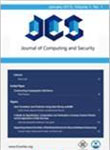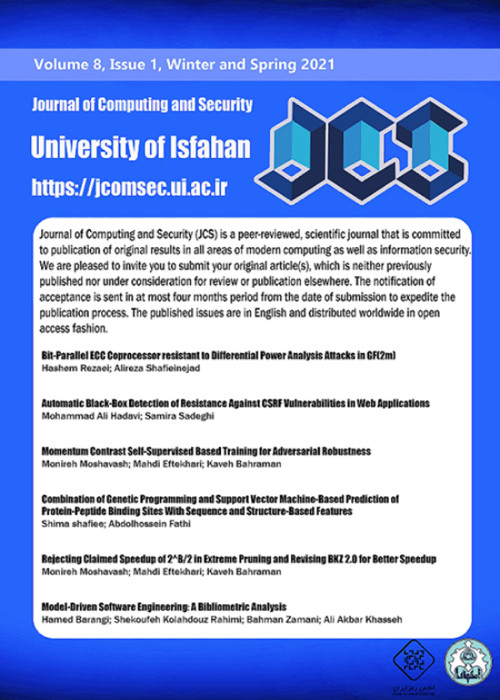فهرست مطالب

Journal of Computing and Security
Volume:3 Issue: 3, Summer 2016
- تاریخ انتشار: 1395/09/20
- تعداد عناوین: 4
-
-
Pages 155-162Critical overlap situations in the classical Hellman's cryptanalytic time memory trade-off method can be avoided, provided that during the precomputation phase, we generate perfect chains which are merge-free and loop-free chains. In this paper, we present asymptotic behavior of perfect chains in terms of time memory trade-off attacks. More precisely, we obtained expected values and variances for the coverage of perfect chains. We have also confirmed our theoretic outcomes with test results.Keywords: Time Memory Trade-Off, Perfect Chains, Random Mapping, Expected Value
-
Pages 163-174Design of secure authentication solutions for low-cost RFID tags is still an open and quite challenging problem, though many protocols have been published in the last decade. In 2013, Wei and Zhang proposed a new lightweight RFID authentication protocol that conforms to the EPC-C1G2 standard and claimed that the protocol would be immune against all known attacks on RFID systems. In this paper, we consider the security of this protocol and show that it cannot provide secure authentication for RFID users. An attacker, by following our suggested approach, will be able to impersonate server/reader, and destroy synchronization between the back-end server and the tag. Finally, we enhance this protocol, and by using formal and informal security analysis we show that the enhanced protocol strongly inhibits the security flaws of its predecessor.Keywords: RFID, EPC-C1G2 Standard, Mutual Authentication, Impersonation, De-Synchronization
-
Pages 175-182In this article, a new stream steganography method for real time digital data network environment with the focus on VoIP is presented. This method consists of a combination of Least Significant Bits (LSB) algorithm and an algorithm called LACK, which is based on the delayed packets in VoIP streams, and forms a new algorithm called LASB (LACK-LSB combination). The combination allows both the reduction of detection probability of stegano data and the use of LSB high capacity as well as being more robust because of diversifying the source of data embedding. That is, by combing these two methods the probability of detection existing steganography data is reduced extensively. Moreover, in the case of detecting stegano data, the potential eavesdropper is not able to easily reconstruct it. To show the performance, both LACK and LSB algorithms are implemented and are compared with the new LASB algorithm in the VoIP environment in terms of capacity, eavesdropping and robustness under several attacks. The experimental results show that LASB is superior to both LACK and LSB in many aspects.Keywords: Steganography, VoIP, LACK, Digital Data Network
-
Pages 183-191Recently, researchers have shown an increased interest in kinship verification via facial images in the field of computer vision. The matter of fact is that kinship verification is done according to similarities of parent and child faces. To this end, we need more local features extraction. All the methods reviewed so far, however, suffer the fact that they have divided images into distinct block, to extract more local features. The main problem has two aspects: aimless division and features extraction from unnecessary regions that lead to overlapping, noise and reduction of classification rate. In this paper, at first, the main parts of face such as eyes, nose and mouth are detected along with the whole face image. Then they will be used for feature extraction. In order to reduce feature vectors redundancy, new method of feature selection named as Kinship Feature Selection (KinFS), based on Random Subset Feature Selection (RSFS) algorithm is proposed. This method reduces the redundancy and improves verification rate by selecting effective features. The experiment results show that purposeful feature extraction by proposed KinFS method are efficient in improving kinship verification rate.Keywords: Kinship Verification, Purposeful Feature Extraction, Redundancy, Feature Selection


